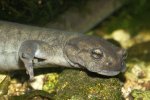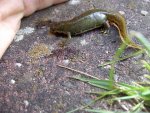Dear Caudata Forum,
I live in Rudolstadt, Thuringia Germany and are mostly interessted in Insects.
Anyway, Im interessted in amphibians, too and googled to determinate a newt we found on an excursion with local enviroment carers (BUND) in a large seep ca. 11 km south of Rudolstadt in May 15. I already know the local newts, as I have the "Berninghausen" and Im sure, it wasent a member of this species, like the crested newt, who occurs mostly in dark shadowed forest swamps and seeps!
And Im sure it wasn`t a Firesalamander, too!
Maybe one of you can help me to determinate ( I have no pic, as we let him free immediatley cause our laws):
This newt was ca 18-20 cm long and brownish- greyish with a big head and relativley big eyes and a big moth with some kind of lipps. As I have googled, he looked mostly simmilar to this photo,
I have found on the web!
regards
Heinz
I live in Rudolstadt, Thuringia Germany and are mostly interessted in Insects.
Anyway, Im interessted in amphibians, too and googled to determinate a newt we found on an excursion with local enviroment carers (BUND) in a large seep ca. 11 km south of Rudolstadt in May 15. I already know the local newts, as I have the "Berninghausen" and Im sure, it wasent a member of this species, like the crested newt, who occurs mostly in dark shadowed forest swamps and seeps!
And Im sure it wasn`t a Firesalamander, too!
Maybe one of you can help me to determinate ( I have no pic, as we let him free immediatley cause our laws):
This newt was ca 18-20 cm long and brownish- greyish with a big head and relativley big eyes and a big moth with some kind of lipps. As I have googled, he looked mostly simmilar to this photo,
I have found on the web!
regards
Heinz


